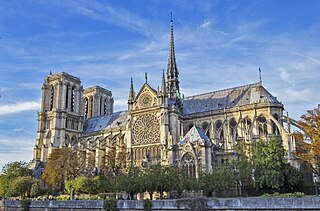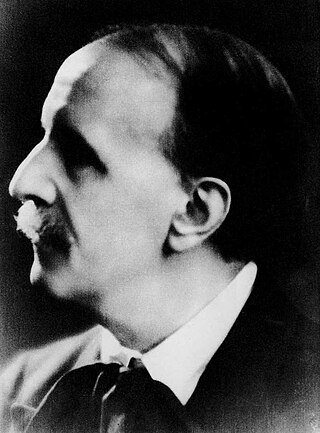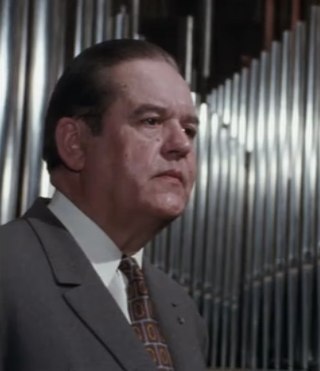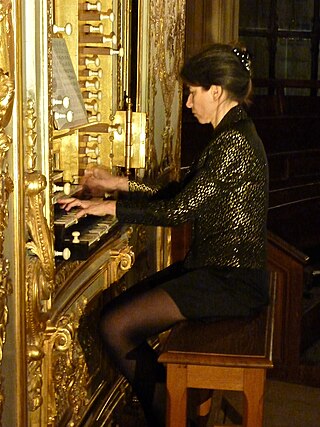
Notre-Dame de Paris, referred to simply as Notre-Dame, is a medieval Catholic cathedral on the Île de la Cité, in the 4th arrondissement of Paris, France. The cathedral, dedicated to the Virgin Mary, is considered one of the finest examples of French Gothic architecture. Several attributes set it apart from the earlier Romanesque style, particularly its pioneering use of the rib vault and flying buttress, its enormous and colourful rose windows, and the naturalism and abundance of its sculptural decoration. Notre-Dame also stands out for its three pipe organs and its immense church bells.

Maurice Gustave Duruflé was a French composer, organist, musicologist, and teacher.

Louis Victor Jules Vierne was a French organist and composer. As the organist of Notre-Dame de Paris from 1900 until his death, he focused on organ music, including six organ symphonies and a Messe solennelle for choir and two organs. He toured Europe and the United States as a concert organist. His students included Nadia Boulanger and Maurice Duruflé.

Louis-Claude Daquin was a French composer, writing in the Baroque and Galant styles. He was a virtuoso organist and harpsichordist.

The Trocadéro, site of the Palais de Chaillot, is an area of Paris, France, in the 16th arrondissement, across the Seine from the Eiffel Tower. It is also the name of the 1878 Trocadéro Palace which was demolished in 1937 to make way for the Palais de Chaillot. The hill of the Trocadéro is the hill of Chaillot, a former village.

The Conservatoire de Paris, also known as the Paris Conservatory, is a college of music and dance founded in 1795. Officially known as the Conservatoire National Supérieur de Musique et de Danse de Paris (CNSMDP), it is situated in the avenue Jean Jaurès in the 19th arrondissement of Paris, France. The Conservatoire offers instruction in music and dance, drawing on the traditions of the 'French School'.
Pierre Eugène Charles Cochereau was a French organist, improviser, composer, and pedagogue.

Jean-Jacques Charles Grunenwald, also known by his pseudonym Jean Dalve, was a French organist, composer, architect, and pedagogue.

Brunoy is a commune in the southeastern suburbs of Paris, Île-de-France, France. It is located 20.6 km (12.8 mi) from the center of Paris. The tenor Louis Nourrit (1780–1831) died in Brunoy.

Saint-Gervais-Saint-Protais is a Roman Catholic parish church located in the 4th arrondissement of Paris, on Place Saint-Gervais in the Marais district, east of City Hall. The current church was built between 1494 and 1657, on the site of two earlier churches; the facade, completed last, was the first example of the French baroque style in Paris. The organists of the church included Louis Couperin and his nephew François Couperin, two of the most celebrated composers and musicians of the Baroque period; the organ they used can still be seen today. The church contains remarkable examples of medieval carved choir stalls, stained glass from the 16th century, 17th century sculpture, and modern stained glass by Sylvie Gaudin and Claude Courageux. Saint-Gervais was a parish church until 1975, when it became the headquarters of the Monastic Fraternities of Jerusalem.

Rolande Roberte Ginabat-Falcinelli was a French organist, pianist, composer, and music educator.

Saint-Louis en l'Île is a Roman Catholic parish church located at 19 Rue Saint-Louis en l'Île on Île Saint-Louis in the 4th arrondissement of Paris, France. It was constructed between 1664 and 1725, and is dedicated to King Louis IX of France, or Saint Louis. The church was originally built in the French Baroque style of the 17th century, but much of the interior decoration was taken or destroyed in the French Revolution. The church was extensively restored and redecorated in the 19th century.
Louis Henry Nicolas Thiry was a French concert organist, composer and pedagogue. He was professor of organ at the Regional Conservatoire in Rouen and played in concerts internationally. His many recordings include the complete organ works of Olivier Messiaen in 1972, which received several awards and led the composer to describe him as "an extraordinary organist". Thiry was blind.
André Louis Marchal was a French organist and organ teacher. He was one of the great initiators of the twentieth-century organ revival in France and one of the cofounders of the Association des amis de l'orgue alongside Norbert Dufourcq.
Éditions Hortus is an independent French disk label, offering largely unknown songs and works for the organ in addition to contemporary compositions. Specialised in organ and choir music, it has in particular presented disks recorded at the Notre Dame de Paris and of its choir 'Les Éléments', as well as of the young harpsichordist Benjamin Alard.

The Église Saint-Paul-Saint-Louis is a church on rue Saint-Antoine in the Marais quarter of Paris. The present building was constructed from 1627 to '41 by the Jesuit architects Étienne Martellange and François Derand, on the orders of Louis XIII of France. It was the first church in Paris to break away entirely from the Gothic style and to use the new Baroque style of the Jesuits, and it had an important influence on Parisian religious architecture. It gives its name to Place Saint-Paul and its nearest Metro station, Saint-Paul. Next door to the church is the Lycée Charlemagne, also founded by the Jesuits.
Louis-Désiré Besozzi was a French pianist, organist and composer. Bezozzi, the fourth generation of this traditional family of wind instrument musicians, composed mainly piano and choral works as well as a four-volume work with exercises for choral singing.

Jean-Baptiste Robin is a French composer and organist.

Marina Nikolayevna Tchebourkina is a French and Russian organist and musicologist. She has a Doktor nauk degree in Science of the Arts. Marina Tchebourkina is known as an expert in French Baroque organ art and an ambassador of Russian organ music.
Henri-Franck Beaupérin is a French organist and improviser.














